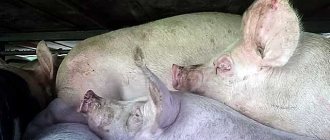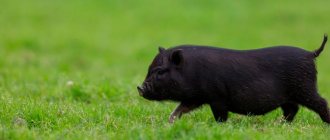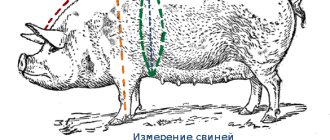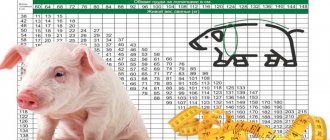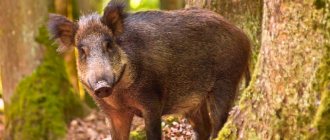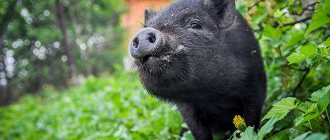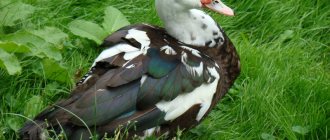If you don’t know how much your adult pig or small piglet weighs, we suggest you look at the weight tables of pigs by size and other characteristics. The main parameter of the health of a domestic pig is body weight, but it cannot be determined 100% by eye, which is why weight tables were invented for these purposes.
Important! The tables below will help you determine the weight of a pig by month and size with an accuracy of 1 kg, especially if you are a novice farmer.
Piglet weight table by week
The weight of young piglets after birth, as well as in the very first days of their life, is most often determined on special, portable scales. Their further estimated weight can be found in the table below. However, when piglets reach a weight of up to 30 kg, they must be divided into pigs for fattening and for breeding the herd.
Calculation of piglet weight by week
| Piglet age in weeks | Live weight in kg |
| 1 | 2.5 kg |
| 2 | 4.5 kg |
| 3 | 7 kg |
| 4 | 9 kg |
| 5 | 11 kg |
| 6 | 14 kg |
| 7 | 18 kg |
| 8 | 22 kg |
| 9 | 26 kg |
| 10 | 30 kg |
Calculation of piglet weight by month
As soon as you have “planted” young piglets for fattening and started raising them for breeding, you can, without using scales, take approximately monthly weight measurements, and then compare them with the indicators on the scales, and you will be convinced that you were able to approximately correctly determine the weight as they develop growth of young pigs.
| Age of young animals in months | Live weight in kg |
| 3 | 38 |
| 4 | 45 |
| 5 | 65 |
| 6 | 85 |
| 7 | 115 |
Important! Young pigs can be sold for meat once they reach 115 kg. because their further fattening will no longer be advisable for several reasons - the meat becomes old, and weight is added due to the greasy layer, thereby the live weight in price can drop significantly. As an exception, and depending on nutrition, a pig by 8-12 months can reach a weight of up to 200 kg.
Conditional assumptions
Of all the described methods for determining how much a pig or an adult pig weighs, the last one is, of course, the most approximate. It does not take into account, for example, factors such as:
- living conditions for animals;
- composition and nutritional value of feed;
- time of year - summer or winter.
According to experts, on balanced feed, the weight of an adult pig can reach 120 kilos in just six months, but if you feed it waste from the kitchen and garden, i.e. boil potatoes for it, grate grain, etc., then the animal will reach this weight only by the year.
Advice. Let's add to the last method a few more facts that are well known to experienced livestock breeders. In summer and spring, pigs gain weight much better than in the cold months, so it is most profitable to buy piglets in the spring. If you have a choice, give preference to two-month-old babies who are able to digest solid food on their own. If you have suckling piglets on your hands, you will have to supplement them with milk for the first month.
Live weight measurement chart for pigs
Adult pigs are considered to be from 9 months of age. We can say that it is at this point that the growth of individuals ends, but not always. The most accurate option for weighing live weight can be determined from the table below.
| Pig length in cm | Chest circumference in cm | Weight in kg |
| 38 cm | 60-68 cm | 11-15 kg |
| 42 cm | 60-72 cm | up to 16 kg |
| 46 cm | 60-72 cm | up to 20 kg |
| 50 cm | 60-80 cm | up to 27 kg |
| 54 cm | 60-84 cm | up to 32 kg |
| 58 cm | 60-88 cm | up to 37 kg |
| 62 cm | 60-92 cm | up to 43 kg |
| 66 cm | 60-96 cm | up to 50 kg |
| 70 cm | 64-100 cm | up to 58 kg |
| 74 cm | 68-104 cm | up to 66 kg |
| 78 cm | 72-104 cm | up to 76 kg |
| 82 cm | 76-112 cm | up to 85 kg |
| 86 cm | 80-116 cm | up to 96 kg |
| 90 cm | 84-116 cm | up to 108 kg |
| 94 cm | 88-120 cm | up to 120 kg |
| 98 cm | 92-128 cm | up to 133 kg |
| 102 cm | 96-132 cm | up to 147 kg |
| 106 cm | 100-132 cm | up to 153 kg |
| 110 cm | 104-140 cm | up to 180 kg |
| 114 cm | 108-140 cm | up to 196 kg |
| 118 cm | 112-148 cm | up to 215 kg |
| 122 cm | 116-148 cm | up to 222 kg |
| 126 cm | 120-148 cm | up to 229 kg |
| 130 cm | 124-148 cm | up to 236 kg |
| 134 cm | 128-148 cm | up to 244 kg |
| 138 cm | 132-148 cm | up to 251 kg |
| 142 cm | 136-148 cm | up to 219 kg |
| 146 cm | 140-148 cm | up to 266 kg |
| 150 cm | 144-148 cm | up to 273 kg |
Important! When you measure the length of an animal's body, its head should look strictly straight, the lower jaw area of the head, chest and neck should be located in one line along the stomach. Make sure that when measuring, the tape measure lies strictly flat and fits snugly against the skin’s bristles. With this approach, the error in weight will be minimal.
Average pig weight
U.V. - slaughter weight,
As you can see, the slaughter yield is determined as a percentage. Thus, the slaughter yield of pig meat is 70 - 85%. It depends on the fatness of the animal.
- For pigs from 80 to 100 kg - 70÷75%.
- From 150 to 180 kg - 80÷82%.
- Above 180 kg - 83÷85%.
The slaughter yield of pigs exceeds that of other large domestic animals. For example,
- in cows it is 50÷60%;
- in goats and sheep - 44÷52%.
When selling a whole pork carcass, the price for it is set at an average price. That is, all parts are sold at the same price. Now it is about 200 rubles for any kilogram of carcass. Old and high-fat animals are sold cheaper. Their meat is of lower quality - tougher and more watery.
The weight of a pig depends primarily on the breed of the animal. So, an individual of the Great White breed will be much heavier than a Vietnamese pig.
Another factor on which the weight of an animal depends is feeding. Details that influence its set include the type of foods consumed, the presence of mixed feed in the diet, and the amount of food eaten.
The weight of an adult great white pig, common in our latitudes, depends on gender. A boar can weigh between 300-350 kg. Females weigh slightly less and have an average weight of 200-250 kg.
U.V. - slaughter weight,
The weight table shows how much the piglet weighs at the time of measuring its length and chest volume. The weight of small pigs is checked monthly in this way, but does not make it possible to understand how correctly the baby pig is developing.
| One month from birth | Average weight, kg | Note |
| 1 | 8-9 | The farmer doesn’t particularly care how much a month-old piglet weighs when it feeds on its mother’s milk - there is always weight gain. Although some continue to weigh their sucklings every week |
| 2 | 12-15 | Balanced, optimized complementary foods are introduced into the diet of little pigs. |
| 3 | 25 | In the third month there is a sharp weight gain - almost twice as much as in the previous period |
| 4 | 45-60 | From this moment on, they try to compare the weight obtained from the table with the parameter indicated here. If the measurement result falls within this interval, there is no need to worry. This weight difference may depend on the breed, as well as the activity of the piglet |
| 5-6 | 75-90 | Piglets are transferred to intensive fattening by introducing high-energy feed into the pig diet |
| 6-7 | 100 | The indicator, compared to the previous period, increased slightly. But this is not evidence that the pig has stopped developing. From six months of age, the cub enters the “league” of gilts, having entered the age of puberty. Therefore, the diet changes completely, this temporarily slows down the growth rate, which will quickly recover in the future. |
| 8-10 | 120-150 | From this period, the pig is considered adult and capable of giving birth. At this stage, there is a division into pigs for brood and those that will be further fattened for slaughter |
Having this information, knowing how much a suckling pig and a six-month-old gilt weigh on average, the farmer can count on the expected weight gain of his livestock. Tabular data based on measurements will allow you to control the entire fattening process in order to identify weak animals in time.
Note! Inconsistencies in all parameters (tabular and standard) are a signal that it is necessary to reconsider the diet and be sure to show the underdeveloped piglet to a veterinarian
Table for determining the weight of pigs
If you are going to raise a pig, then you must take into account that at about the age of 7, the growing, replacement pig has already reached sexual maturity. When a pig goes into heat, at this moment growth and weight may stop, sometimes even weight loss occurs.
Farmers with experience in pig breeding carry out the first mating no later than 10 months, when the sow reaches approximately 120 kg. The sow weight table is listed just above. After each farrowing, the sow usually gains up to 25 kg in weight. For example, at the first mating your sow weighed 115 kg, by the time of the second mating the sow can already weigh 140 kg, etc. ascending.
Average weight of pig organs
We determined the weight of pigs by size in the tables above. After the slaughter of an animal, it is left with a lot of internal organs, most of which are edible and don’t even taste like anything.
| Name of internal organ | Weight in kg |
| Bones | from 10 to 12 kg |
| Heart | from 300 to 350 g |
| Head | from 8 to 10 kg |
| Lungs | from 800 to 900 gr |
| Liver | from 1.5 to 1.8 kg |
| Kidneys | from 250 to 270 g |
| Salo | from 20 to 27 kg |
| Waste | from 3 to 5 kg |
Important! As you can see, finding out the weight of a pig from the tables that we described above is not difficult and it’s enough just to know the size. All the tables of pig weights presented above are approximate according to measurements, but something is close to the exact value. Be sure to weigh everything on the scales.
Ripening of pork meat after slaughter
After the slaughter of an individual, various processes occur in the meat that determine its quality properties. A distinction is made between rigor rigor and softening (ripening of meat).
After several days in the refrigerator at a temperature of 5-10 degrees above zero, the pork will become flavorful. The product acquires excellent taste characteristics, juice comes out of it - an indicator that the meat is ripening.
A characteristic feature is the appearance of a “dry crust” on the carcass, elasticity and a specific smell. To determine the degree of ripening of pork, histological and chemical studies are used.
Long-term storage of this product without freezing leads to a change in its consistency, color, release of watery juice and the appearance of a musty odor. As a result, putrefactive microflora develops, and the pork begins to deteriorate instantly.
